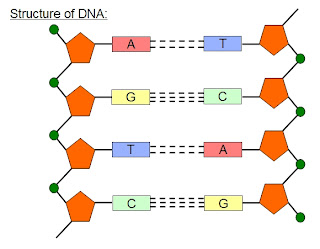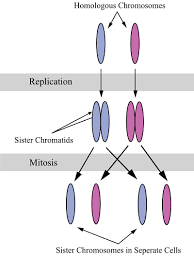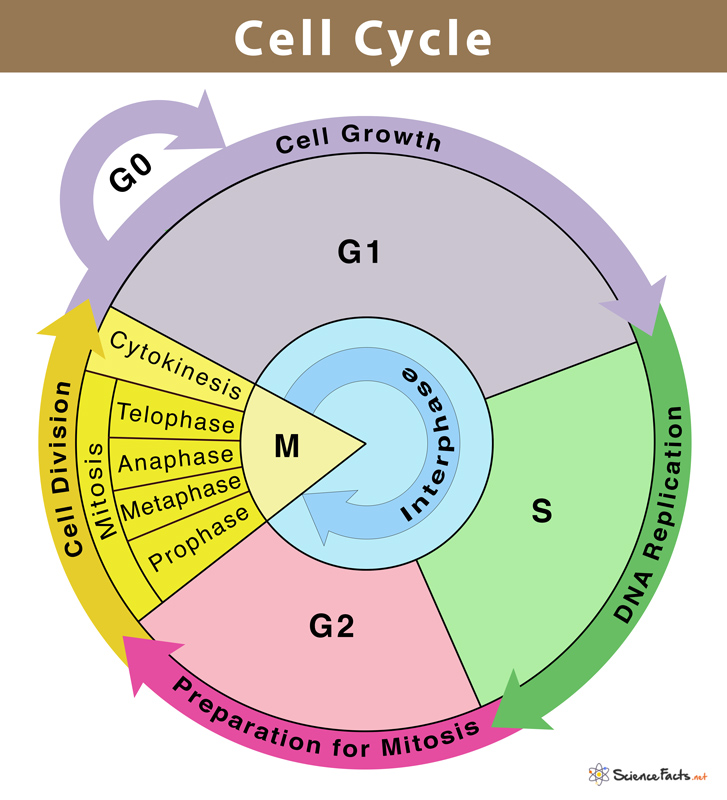Obj 13A-B Structure and Replication & Obj 9A-B Cell Cycle
Objective 13A: DNA Replication (13.2)
13.1.1 Describe the structure of DNA including the makeup of the nucleotide monomers and overall shape.
Overall Shape & Structure: Double Helix, backbone/side of ladder-alternating sugar and phosphate groups, rungs of ladder-bases that are bonded through hydrogen bonds, antiparallel strands
Nucleotide Monomer Makeup: deoxyribose, phosphate group, one of four nitrogen bases (adenine, thymine, cytosine, or guanine)
13.1.2 Explain the antiparallel nature of DNA and the significance of the 5’ and 3’ ends of a DNA strand.
The 2 strands run in opposite directions
Crucial because it establishes directionality, allowing DNA polymerase to make new strands in a specific direction
13.1.3 Explain how Chargaff’s rules relate to the structure of DNA.
Chargaff’s Rule - A=T and G=C
13.3.1 Using fig. 13.23 as a guide, describe DNA packing into a eukaryotic chromosome focusing specifically on the role proteins play.
DNA wraps around histone proteins to form nucleosomes, which are then coiled into chromatin fibers. Additional proteins further compact and organize these fibers into loops and coils to form the highly condensed structure of a chromosome during cell division.
histone proteins —> nucleosomes (DNA coiled around histone proteins) —> chromatin fibers (condensed nucleosomes) —> chromosome (chromatin fibers formed in x)


Objective 13B: DNA Replication (13.2)
13.2 1 Explain what is meant by the term “semi-conservative” replication.
Semi-Conservative Replication - the process where DNA makes copies of itself, resulting in two new DNA molecules, each consisting of one original strand and one newly synthesized strand
13.2.2 Describe the process of DNA replication including the functions of the following enzymes that aid in the process: Helicase, topoisomerase, DNA polymerases, ligase.
Unwinding the Double Helix
Helicase - unzips the DNA double helix by breaking the hydrogen bonds between base pairs, separating the two strands
Topoisomerase - relieves the tension and supercoiling from helicase by creating temporary cuts in the DNA backbone and then rejoining them, preventing the DNA from becoming tangled
Synthesizing New DNA Strands
Primase - synthesizes short RNA primers, which provide a starting point to attach new nucleotides
DNA Polymerases - binds to the primer and moves along the template strand, adding complementary DNA nucleotides to the 3’ end, has proofreading functions to correct errors
leading strand - **refer to above
lagging strand - short fragments (okazaki fragments)
Joining the New Strands
Ligase - acts as a gluer, forming the final bonds to seal nicks and create a continuous DNA strand after RNA primers are replaced by DNA
13.2.3 Explain what the 5’ and 3’ ends of a DNA molecule are and how they impact DNA replication
refer to the carbon atoms on the deoxyribose sugar in the backbone of the DNA strand
5’ end has a phosphate group, 3’ has -OH to the 3rd carbon
crucial because DNA polymerase can only synthesize new DNA by adding nucleotides to the 3’ end
13.2.4 Explain what Okazaki fragments are, why they are made, and how they’re linked together.
Okazaki Fragments - short segments of DNA synthesized on the lagging strand because DNA polymerase can only build in the 5’ —> 3’ direction
To create the lagging strand (3’—>5’) replication must occur discontinuously which fragments are later linked together by DNA ligase
Objective 9A: Cell Division and Cell Cycle (9.1 & 9.2)
9.1.2 Explain why cell division is essential for prokaryotic and eukaryotic life.
fundamental process for reproduction, growth, and repair
9.1.3 Differentiate between the following terms:
Chromosomes and chromatin
Somatic cells and gametes
Mitosis and cytokinesis
Chromatin - loosely coiled DNA that condenses into tightly packed chromosomes during cell division
Chromosomes - condensed chromatin fibers, forming organized structures
Somatic Cells - all body cells except for reproductive cells
Gametes - reproductive cells, such as sperm and cell eggs
Mitosis - division of the nucleus
Cytokinesis - the subsequent division of the cytoplasm to form two separate daughter cells
9.1.4 Draw a model showing how a single chromosome duplicates through to become sister chromatids, then becomes two chromosomes. Label the structures as shown in Figure 9.5.
chromosome becomes 2 sster chromatids when its DNA replicates during the S phase of interphase

9.2.1 Draw a model of the cell cycle. Use and describe these terms in your model: mitosis, interphase, G1, G2, cytokinesis, S phase, DNA replication, two new daughter cells.

interphase - the long phase of the cell cycle when a cell grows, performs its normal functions, and prepares for division by replicating its DNA
G1 - cell grows
S Phase - DNA Replication, resulting in two identical sister chromatids attached at the centromere
G2 - cell continues to grow and prepares for mitosis
mitosis - the process by which a cell replicates its chromosomes and then segregates them, producing two identical nuclei in preparation for cell division
cytokinesis - the final stage of cell division where the cell’s cytoplaasm divides to form two daughter cells
9.2.2 Describe the characteristics of each phase of mitosis.
Prophase - chromosomes condense and become visible, while the nuclear envelope breaks down
Metaphase - chromosomes align at the cell’s equator along the metaphase plate
Anaphase - sister chromatids separate and are pulled to opposite poles of the cell
Telophase - two new nuclei form around the separated chromosomes, and the chromosomes decondense
Objective 9B: Cell Cycle Regulation & Cancer (9.3)
9.3.3 Describe the role checkpoints play in the cell cycle.
cell cycle checkpoints - control mechanisms that monitor and regulate the cell cycle, ensuring each phase is accurately completed before the cell progresses to the next
9.3.4 What is the biological basis given in the text for each cell cycle phase (G1, G2, M)?
G1 - cell growth and normal function
G2 - further growth and preparation for division DNA replication
M - the physical separation of the cell into two daughter cells
9.3.5 What is the G0 phase and what is the benefit of stopping at the G1 checkpoint?
allows the cell to repair any issues or permanently exit the cell cycle (entering G0), preventing the replication of damaged DNA and the production of potentially cancerous cells
9.3.6 Explain how cancerous cells are different from healthy cells.